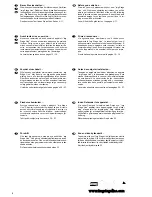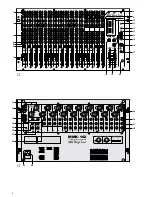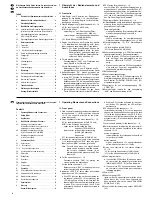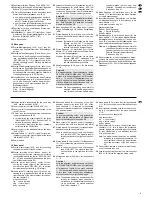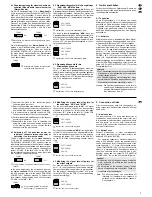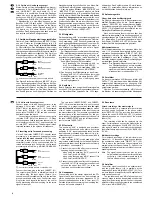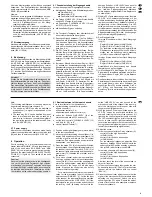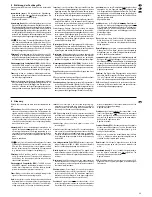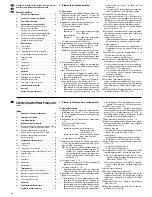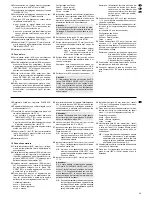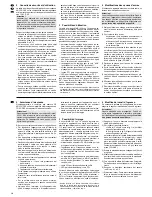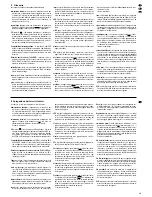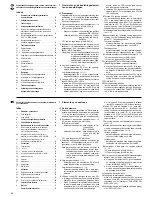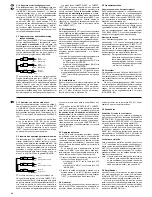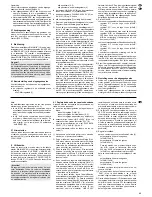
6.2 Einstellungen für die Ausspielwege
a Wird ein Ausspielweg als Effektweg verwendet,
sollte er post-fader ausgelegt sein (Signalabgriffs-
punkt nach den Kanalfadern). Der Ausspielweg
„AUX“ ist ab Werk auf post-fader geschaltet.
b Wird ein Ausspielweg als Monitorweg verwendet,
sollte er pre-fader ausgelegt sein (Signalabgriffs-
punkt vor den Kanalfadern). Der Ausspielweg
„MON“ ist ab Werk auf pre-fader geschaltet.
Bei Bedarf kann der Ausspielweg „AUX“ auf pre-fader
umgestellt werden und der Ausspielweg „MON“ auf
pre-equalizer oder post-fader – siehe dazu Kap. 4.2.
1) Mit den Reglern „AUX“ bzw. „MON“ (3) die Sig-
nale der Eingangskanäle wie gewünscht auf den
Ausspielweg „AUX“ bzw. „MON“ mischen
2) Die Summensignale der Ausspielwege liegen je-
weils an den Ausgängen „AUX SEND“ bzw.
„MON SEND“ (26) an; den Ausgangspegel mit
dem jeweiligen Summenregler des Ausspielwegs
„AUX SEND“ bzw. „MON SEND“ (14) einstellen.
3) Wird ein Ausspielweg als Effektweg genutzt,
kann das vom Effektgerät bearbeitete Signal ent-
weder über einen freien Eingangskanal oder über
die Buchsen „AUX-IN“ (27) wieder in das Misch-
pult zurückgeführt werden. Das Signal mit dem
Pegelregler des benutzten Eingangs [jeweiliger
Kanalfader (7) bzw. Regler „AUX IN“ (18)] auf das
Mastersignal mischen.
6.3 Mischen der Tonquellen
1) Die Masterfader (19) so weit aufziehen, dass das
Mischungsverhältnis der angeschlossenen Ton-
quellen optimal eingestellt werden kann.
2) Mit den Kanalfadern (7) das gewünschte Laut-
stärkeverhältnis der Tonquellen einstellen: Die
Tonquellen, die am lautesten zu hören sein sollen,
optimal aussteuern (siehe Kap. 6.1) und die Pegel
der übrigen Tonquellen entsprechend reduzieren.
Ist eine zusätzliche Tonquelle am Eingang
„AUX-IN“ (27) oder „PLAYBACK“ (23) angeschlos-
sen, das Signal dieser Tonquelle mit dem Pegel-
regler „AUX IN“ (18) bzw. „PLAYBACK LEVEL“
(15) auf die Signalsumme mischen.
3) Damit die Aussteuerungsanzeige (10) den Mas-
terpegel anzeigt, darf keine der PFL-Tasten (6)
gedrückt sein.
4) Mit den Masterfadern den endgültigen Pegel des
Stereo-Mastersignals einstellen, das am Master-
ausgang „MAIN MIX OUTPUT“ (21) anliegt. Den
Pegel für das Signal am Aufnahmeausgang „RE-
CORD“ (22) mit dem Regler „RECORD LEVEL“
(13) einstellen (das Signal für den Ausgang „RE-
CORD“ wird nach den Masterfadern abgegriffen).
In der Regel wird eine optimale Aussteuerung
erreicht, wenn die Aussteuerungsanzeige bei
durchschnittlich lauten Passagen Werte im 0-dB-
Bereich anzeigt (Anzeige 0 dB = 1,23 V). Ist der
Ausgangspegel jedoch für das nachfolgende
Gerät zu hoch oder zu niedrig, muss das Master-
signal entsprechend niedriger oder höher ausge-
steuert werden.
6.4 Abhören über Kopfhörer
Über einen Stereo-Kopfhörer, angeschlossen an der
Buchse (17), können ein oder mehrere Eingangs-
kanäle vorgehört (PFL = pre fader listening) bzw.
das Mastersignal abgehört werden. Die Aussteue-
rungsanzeige (10) zeigt dabei immer das Signal an,
welches über den Kopfhörer zu hören ist.
1) Um das Mastersignal post-fader abzuhören, alle
PFL-Tasten (6) ausrasten.
2) Um einen oder mehrere Eingangskanäle gleich-
zeitig pre-fader abzuhören, die zugehörige/n
PFL-Taste/n drücken. Das Signal ist technisch
bedingt nur monofon zu hören.
3) Die Lautstärke für den Kopfhörer mit dem Regler
„PHONES“ (16) einstellen.
7
Technische Daten
Eingänge
Mic, sym., mono: . . . . . . . . . . 0,3 mV, Gain min.: 65 mV
Line, sym., mono: . . . . . . . . . . 2,3 mV, Gain min.: 560 mV
Line, sym., stereo: . . . . . . . . . 70 mV, +4 dBu.: 210 mV
Aux-In, sym., stereo: . . . . . . . 140 mV
Playback, asym., stereo: . . . . 140 mV
Insert-Return, Kanal, asym.: . . 240 mV
Insert-Return, Master, asym.: . 400 mV
Ausgänge
Master L/R, sym., stereo: . . . 1,23 V/75
Ω
Record, asym., stereo: . . . . . . 600 mV/600
Ω
Insert-Send (Kanal), asym.: . . 180 mV/< 22
Ω
Insert-Send (Master), asym.: . 300 mV/< 22
Ω
Direct Out, asym., mono: . . . . 565 mV/100
Ω
(post-fader)
Aux Send, asym., mono: . . . . 3 V/100
Ω
(post-fader)
Mon Send, asym., mono: . . . . 985 mV/100
Ω
(pre-fader)
Kopfhörer, asym., stereo: . . . . 600 mV/32
Ω
Frequenzbereich: . . . . . . . . . . . . 10 – 30 000 Hz
Klirrfaktor: . . . . . . . . . . . . . . . . . . < 0,1 %
Störabstand: . . . . . . . . . . . . . . . . 85 dB, bewertet
Übersprechen: . . . . . . . . . . . . . . -80 dB
äquivalentes Eingangsrauschen
im Bereich 20 Hz – 20 kHz (bei Rs = 150
Ω
)
Mic: . . . . . . . . . . . . . . . . . . . . . -128 dBu
Mono-Line/Stereo-Line: . . . . . -100 dBu/-87 dBu
Aux-In: . . . . . . . . . . . . . . . . . . -96 dBu
Aussteuerungsanzeige: . . . . . . . 0 dB = 1,23 V
Klangregelung Mono-Kanäle
Tiefen: . . . . . . . . . . . . . . . . . ±15 dB/60 Hz
Mitten: . . . . . . . . . . . . . . . . . ±15 dB/250 – 6000 Hz
Höhen: . . . . . . . . . . . . . . . . . ±15 dB/12 kHz
Klangregelung Stereo-Kanäle
Tiefen: . . . . . . . . . . . . . . . . . ±15 dB/45 Hz
Höhen: . . . . . . . . . . . . . . . . . ±15 dB/12 kHz
Phantomspeisung: . . . . . . . . . . . +48 V
Stromversorgung: . . . . . . . . . . . . 230 V~/50 Hz/26 VA
zulässige Einsatztemperatur: . . . 0 – 40 °C
Abmessungen: . . . . . . . . . . . . . . 482 x 267 x 125 mm, 6 HE
Gewicht: . . . . . . . . . . . . . . . . . . . 7 kg
Laut Angaben des Herstellers.
Änderungen vorbehalten.
6.2 Adjustments for the send ways
a If a send way is used as an effect way, it should
be designed post-fader (signal is taken after the
channel faders). The send way “AUX” is factory-
set to post-fader.
b If a send way is used as a monitor way, it should
be designed pre-fader (signal is taken ahead of
the channel faders). The send way “MON” is fac-
tory-set to pre-fader.
If required, the send way “AUX” can be modified to
pre-fader and the send way “MON” to pre-equalizer
or post-fader – see chapter 4.2.
1) Use the controls “AUX” or “MON” (3) to mix the
signals of the input channels to the send way
“AUX” or “MON” as desired.
2) The master signals of the send ways are availa-
ble at the outputs “AUX SEND” or “MON SEND”
(26) respectively; adjust the output level with the
corresponding master control of the send way
“AUX SEND” or “MON SEND” (14).
3) If a send way is used as an effect way, the signal
processed by the effect unit can be returned to
the mixer either via an unconnected input chan-
nel or via the jacks “AUX-IN” (27). Mix the signal
to the master signal with the level control of the
input used [corresponding channel fader (7) or
control “AUX IN” (18)].
6.3 Mixing the audio sources
1) Advance the master faders (19) until the mixing
ratio of the audio sources connected can be ad-
justed to an optimum level.
2) Use the channel faders (7) to adjust the desired
volume ratio of the audio sources: Adjust the au-
dio sources to be heard at the highest volume to
an optimum level (see chapter 6.1); reduce the
levels of the other audio sources accordingly.
With an additional audio source connected to
the input “AUX-IN” (27) or “PLAYBACK” (23), mix
the signal of this audio source to the master sig-
nal with the level control “AUX IN” (18) or “PLAY-
BACK LEVEL” (15).
3) To indicate the master level by means of the peak
program meter (10), none of the PFL buttons (6)
must be pressed.
4) Use the master faders to adjust the final level of
the stereo master signal available at the master
output “MAIN MIX OUTPUT” (21). Adjust the lev-
el for the signal at the recording output “RE-
CORD” (22) with the control “RECORD LEVEL”
(13) [the signal for the output “RECORD” is taken
after the master faders].
Usually an optimum level control is obtained
when the peak program meter shows values in
the 0 dB range (indication 0 dB = 1.23 V) with mu-
sic passages of average volume. However, if the
output level is too high or too low for the following
unit, the level of the master signal must be in-
creased or decreased accordingly.
6.4 Monitoring via headphones
Via stereo headphones connected to the jack (17),
the master signal or one or several input channels
can be monitored (PFL = pre-fader listening). In this
case, the peak program meter (10) will always indi-
cate the signal to be heard via the headphones.
1) For post-fader monitoring of the master signal,
unlock all PFL buttons (6).
2) For simultaneous pre-fader monitoring of one or
several input channels, press the corresponding
PFL button(s). Due to technical reasons, the sig-
nal is monophonic only.
3) Adjust the headphone volume with the control
“PHONES” (16).
7
Specifications
I
nputs
Mic, bal., mono: . . . . . . . . . . 0.3 mV, gain min.: 65 mV
Line, bal. mono: . . . . . . . . . . 2.3 mV, gain min.: 560 mV
Line, bal., stereo: . . . . . . . . . 70 mV, +4 dBu.: 210 mV
Aux-In, bal., stereo: . . . . . . . . 140 mV
Playback, unbal., stereo: . . . 140 mV
Insert-Return, channel, unbal.: 240 mV
Insert-Return, master, unbal.: 400 mV
Outputs
Master L /R, bal., stereo: . . . 1.23 V/75
Ω
Record, unbal., stereo: . . . . . 600 mV/600
Ω
Insert-Send (channel), unbal.: 180 mV/< 22
Ω
Insert-Send (master), unbal.: 300 mV/< 22
Ω
Direct Out, unbal., mono: . . . 565 mV/100
Ω
(post-fader)
Aux Send, unbal., mono: . . . 3 V/100
Ω
(post-fader)
Mon Send, unbal., mono: . . . 985 mV/100
Ω
(pre-fader)
Headphones, unbal., stereo: . 600 mV/32
Ω
Frequency range: . . . . . . . . . . . 10 – 30 000 Hz
THD: . . . . . . . . . . . . . . . . . . . . . < 0.1 %
S/N ratio: . . . . . . . . . . . . . . . . . 85 dB, weighted
Crosstalk: . . . . . . . . . . . . . . . . . -80 dB
Equivalent input noise
in the range 20 Hz – 20 kHz (at Rs = 150
Ω
)
Mic: . . . . . . . . . . . . . . . . . . . . -128 dBu
Mono-Line, Stereo-Line: . . . . -100 dBu/-87 dBu
Aux-In: . . . . . . . . . . . . . . . . . -96 dBu
Peak program meter: . . . . . . . . 0 dB = 1.23 V
Equalizer, mono channels
low frequencies: . . . . . . . . . ±15 dB/60 Hz
midrange frequencies: . . . . ±15 dB/250 – 6000 Hz
high frequencies: . . . . . . . . ±15 dB/12 kHz
Tone control, stereo channels
low frequencies: . . . . . . . . . ±15 dB/45 Hz
high frequencies: . . . . . . . . ±15 dB/12 kHz
Phantom power: . . . . . . . . . . . . +48 V
Power supply: . . . . . . . . . . . . . . 230 V~/50 Hz/26 VA
Admissible ambient temp. . . . . . 0 – 40 °C
Dimensions: . . . . . . . . . . . . . . . 482 x 267 x 125 mm, 6 RS
Weight: . . . . . . . . . . . . . . . . . . . 7 kg
According to the manufacturer.
Subject to technical modification.
10
GB
D
A
CH
Diese Bedienungsanleitung ist urheberrechtlich für MONACOR
®
INTERNATIONAL GmbH & Co. KG
geschützt. Eine Reproduktion für eigene kommerzielle Zwecke – auch auszugsweise – ist untersagt.
All rights reserved by MONACOR
®
INTERNATIONAL GmbH & Co. KG. No part of this instruction manual
may be reproduced in any form or by any means for any commercial use.


